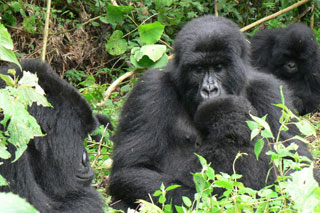
Gorillas vs. charcoal: Biomass to the rescue
Apr 23, 2007 - Scientific American - sciam.com
 |
Every day, Virunga National Park gets a little bit smaller. The forest, in the Democratic Republic of Congo, is one of the last homes of the majestic mountain gorilla (Gorilla beringei beringei). It is also the main source of energy—in the form of wood—for the millions of people who live in areas surrounding the park, only 6 percent of whom have access to electricity.
Just 720 mountain gorillas remain in the world, half of which live in Virunga National Forest, the others in nearby Rwanda and Uganda.
Criminal gangs, the military and rebel groups from Rwanda all benefit financially from Virunga's deforestation. The trees are chopped down and burned to feed the area's "almost insatiable demand for charcoal," which is the primary means of fuel for heating, cooking and sanitizing water in the area, according to the Rwanda News Agency. Anyone who gets in the way of the charcoal trade—be it park rangers or gorillas—is often murdered.
According to the official Web site of Virunga National Park, "charcoal stands as the single biggest threat to the mountain gorillas and other flora and fauna in the park."
Combating the charcoal trade has been a tough fight. According to a report last year in National Geographic, the charcoal industry was worth more than $30 million in 2006, compared to the $300,000 the gorilla park attracted to the region through eco-tourism.
With so much money at stake, and so few alternatives to charcoal, little can be done to stop the illegal activities. But now a new tool in the fight against charcoal has emerged. It promises not only hope for the gorillas, but for the economically beleaguered region.
 "In order to put further resistance against charcoal trade, we need to offer an alternative to people," says Virginia Echavarria, who is in charge of introducing a new sustainable technology to the region for the Africa Conservation Fund, headquartered in Tucson, Ariz. Echavarria plans to bring 1,000 biomass briquette pressing machines to the area by the end of the year, a goal that could result in 145,000 people using sustainably produced fuel briquettes instead of charcoal. "In order to put further resistance against charcoal trade, we need to offer an alternative to people," says Virginia Echavarria, who is in charge of introducing a new sustainable technology to the region for the Africa Conservation Fund, headquartered in Tucson, Ariz. Echavarria plans to bring 1,000 biomass briquette pressing machines to the area by the end of the year, a goal that could result in 145,000 people using sustainably produced fuel briquettes instead of charcoal.
"We already have 130 biomass briquette pressing machines on the ground," in the Democratic Republic of Congo's North Kivu province, Echavarria says. Each wooden press takes six to eight people to operate and can produce upwards of 500 briquettes a day. But implementation is complex: A production site requires a hangar to house the machines, a greenhouse to dry the briquettes, areas to make compost to form the briquettes, and training.
"After three weeks of training, the 130 machines should be pressing 65,000 fuel briquettes per day," Echavarria says.
To make the briquettes, "we use sawdust, rice husks, coffee and tea residues, sorghum and plentiful available leaves and grass. As long as [the biomass sources] are dried, they are great for making compost," Echavarria says. The briquettes are made in specially designed metal stoves. Each one costs just $5.50 and has a removable combustion chamber that can be powered with fuel briquettes, fuelwood, or even charcoal if absolutely necessary, and they require much less fuel than would be used for cooking or heating purposes.
A 50-kilogram sack of fuel briquettes costs just $12 a sack, compared to $25 a sack for charcoal, and the briquettes are easier to use, according to Echavarria. "The advantage about fuel briquettes is that they start up really fast—after two minutes you can place the pan—while charcoal can take up to 15 minutes to be lighted up," she says.
If Echavarria meets her goal of 1,000 briquette presses by the end of the year, it could mean the creation of up to 7,500 jobs. "It is not only the people pressing, but also the park rangers giving information, the women selling the fuel briquette sacks in Goma, etc.," Echavarria says.
The first 130 briquette presses were purchased with funding from SenterNovem, an agency of the Dutch Ministry of Economic Affairs that promotes sustainable development and innovation. The next step is buying 100 more pressing machines in the next month. Virunga National Park hopes to raise $28,897 through online donations to pay for the machines.
Images: Mountain gorillas, the biomass briquette process © Africa Conservation Fund. Used with permission.

|




 "In order to put further resistance against charcoal trade, we need to offer an alternative to people," says Virginia Echavarria, who is in charge of introducing a new sustainable technology to the region for the Africa Conservation Fund, headquartered in Tucson, Ariz. Echavarria plans to bring 1,000 biomass briquette pressing machines to the area by the end of the year, a goal that could result in 145,000 people using sustainably produced fuel briquettes instead of charcoal.
"In order to put further resistance against charcoal trade, we need to offer an alternative to people," says Virginia Echavarria, who is in charge of introducing a new sustainable technology to the region for the Africa Conservation Fund, headquartered in Tucson, Ariz. Echavarria plans to bring 1,000 biomass briquette pressing machines to the area by the end of the year, a goal that could result in 145,000 people using sustainably produced fuel briquettes instead of charcoal.